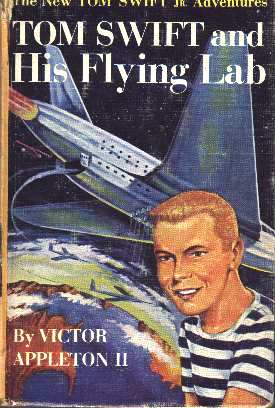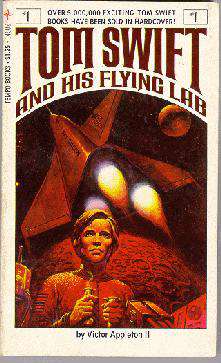
Tom Swift and His Flying Lab
By Victor Appleton II
Summary
: The following summary was extracted from the dustjacket of this book and e-mailed to me by Christopher Pepin. Thanks!This brand new series of adventures for boys introduces Tom Swift Jr., son of the famous inventor of a generation ago. Young Tom is now an inventor in his own right. As an associate in his father's great enterprise at Shopton, his brilliant mind is seething with the inventive genius that will make him even better known than his father.
In this first exciting book of the new TOM SWIFT JR. series, Tom's gigantic flying laboratory will carry you faster than sound into a thrilling struggle against a gang of international enemies. Tom must overcome the scheming of this game as well as terrific mechanical problems to build his fabulous aircraft, which will soar straight up from the ground, fly at supersonic speeds, and carry scout planes in it's own hanger.
When the Sky Queen is completed, Tom and his friend Bud Barclay take off for South America where the same enemies are seeking to gain control of a mountain of uranium. The tense action of their adventures fills every chapter.
Each scientific detail of this fascinating story has been carefully checked. Tom Swift's inventions may be years ahead of the time, just as his father's were in their time, but they are all plausible and some day you may see them in use.
![]()
Major Inventions

The biggest invention in this book is, of course, the
Flying Lab. The Flying Lab a 3 story atomic-powered aircraft that is completely outfitted with all the equipment a scientist could ever need. Jet lifters provide an easy way to land in tight spots, and atomics give it almost unlimited range. The Flying Lab is completely coated with Tomasite, an extremely tough, hard, lightweight plastic that can absorb most cosmic rays. Tom uses the Flying Lab whenever he needs to travel cross-continentally.How does the Flying Lab work?
The Flying Lab works like all other aircraft. This one, however, has a cruising speed of 1,200 miles per hour and seems to have no maximum altitude (different books, such as #30, sight him at flying at 400,000 feet).
How feasible is it to build a Flying Lab?
It is not only entirely possible to build ships with the capabilities of the Flying Lab, but such ships have already been built. NASA, for instance, recently bought a huge "Supper Guppy" from Europe that it plans to use to ferry enormous pieces of the space station around the country. The Air Force has its Harrier Jump Jet, which can duplicate the VTOL (Vertical Takeoff and Landing) capabilities of the Flying Lab.However, the Flying Lab does have one thing that the others lack: a nuclear propulsion system. The reason for this is simple: what would you do with the radiation?
If you built a Flying Lab, how much impact would it have on civilization?
The Flying Lab would have a large range of uses, mostly because of its enormous size, range, and speed (at 1200mph it can break the sound barrier, and due to atomics it could circle the globe several times without needing refueling). The Air Force would undoubtedly want one, and I'm sure that the scientific community could find some uses for it as well (it would be great on safari's, for example, or on polar expeditions). Commercial aircraft carriers might want a few for those long Tokyo-London or London-Sydney routes. The cargo business might buy a few as well and utilize its enormous carrying capacity.In short, while it would have a lot of uses, it wouldn't really revolutionize the world. Its atomic motors, however, would be another storyÖ
Another major invention is the
Electronic Amulet, a device that prevents a person from setting off Tom's special alarm system. Tom's alarm system protects both Swift Enterprises and his home; it is unknown whether the Citadel also has the system. The Amulet, of course, is used in all the Tom Swift books and generally does its best at keeping intruders out (although invariably the enemy has some method to thwart it).How the Electronic Amulet works:
In the words of Tom Swift:"It sounds complicated, but it's really simple," Tom explained. "The little bracelet traps radar impulses and keeps them off our scopes. There's a giant scope on top of the main building now for everyone to see, and a special one down here in the office for the underground hangar. So," Tom went on, as Chow looked perplexed, "anyone who doesn't wear an amulet causes a little dot of light to show up on one scope or the other. That's how we can tell if a spy has sneaked in."
How feasible would it be to build an Electronic Amulet
? The Amulet must have been very hard to create. No material (that is, no unclassified material) is currently known that can absorb radar impulses with any kind of efficiency. Still, I suppose it is possible that, given enough time in money, someone could create such a metal. It would still be mighty hard to do, though.The amulet system does have one major problem, though. You see, unless you used a different radar beam and a correspondingly different material for each amulet system any amulet would be able to defeat any alarm system. Supposedly Tom Swift had a way to combat this, since we never heard of anyone using a plant amulet to sneak into the Swift's residence.
How much impact would it have on civilization
? The amulet and the security system it is a part of would probably have a minimal impact on society, as we already have a lot of perfectly good alarm systems. It might be used in certain sensitive government installations and businesses, but other than that there would probably be no place for it (which explains why Tom never tried to market it).
Interesting side-note:
In the book Tom Swift and his Triphibian Atomicar Tom gives one of his wristwatches to a tribal chief in Kabulistan. This, as Bud points out, enables them to sneak past the Swift alarm systems!
![]()
Minor Inventions:
The Damonscope (named after old Mr. Damon, a very colorful character in the Tom Swift Sr. series who was always blessing something), which can photograph uranium deposits by sensing radiation; the Skeeter, a midget helicopter; and the Pigeon Special, a small commuter aircraft possibly built as a replacement for the Cessena.
![]()
[No previous book] |
Tom Swift and his Jetmarine | Index